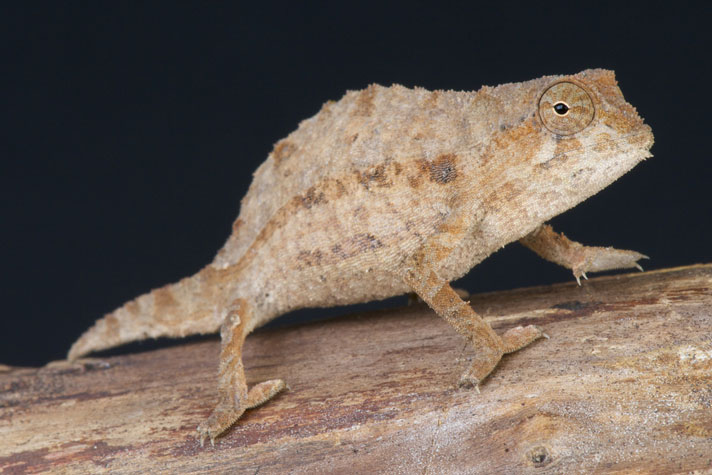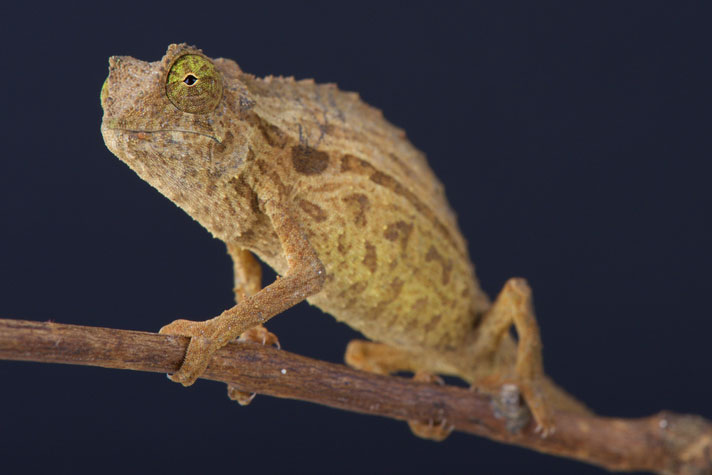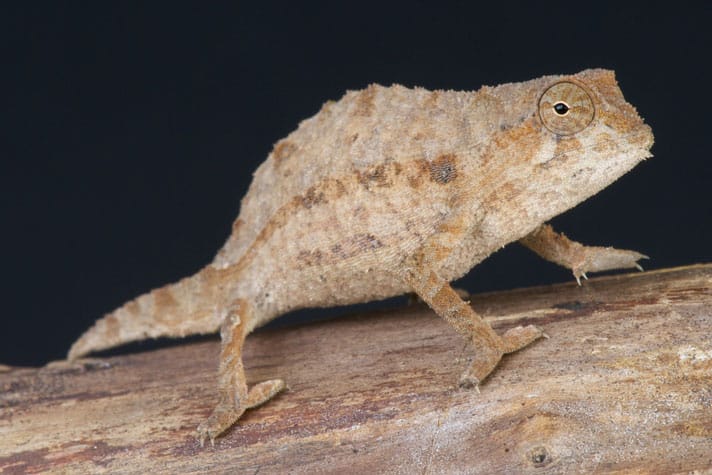For such tiny animals, bearded leaf Chameleon are remarkably durable and hardy.
The bearded leaf chameleon (Rieppeleon brevicaudatus) is known for having several common names, including stump-tailed chameleon, and also several scientific names. I prefer the ‘leaf’ designation, as they do strongly resemble a dead leaf, and they don’t appear to be ‘dwarfed’ versions of larger chameleons, but are simply small. They are found in the Eastern Usambara and Uluguru Mountains in the Eastern Arc region of Tanzania, an area that has been compared to the Galapagos Islands in terms of isolation and species diversity. Although they are commonly exported, little specific information is available on their natural habitat, though they are known to prefer the under story close to the ground in the relatively cool tropical forests where they occur.

reptiles4al/Shutterstock
The bearded leaf chameleon (Rieppeleon brevicaudatus) is known for having several common names, including stump-tailed chameleon.
They are found in a variety of subtle colors, including green, tan, and brown, and have some capability to change colors as well. The courting males often sport bright longitudinal stripes, whereas the females are typically less flamboyant. They are much like their larger relatives except for their short tail, which is nonetheless often used for support when taking prey or while climbing. The ’bearded’ name refers to the tiny goatee that, under close observation, can be seen on the chin of this species. Otherwise, they resemble several other species of ‘leaf’ or ‘dwarf’ chameleons found in the larger area.
Bearded Leaf Chameleon Availability
This species is currently not listed in CITES. They are apparently quite common where they are found and are widely available at reasonable prices among pet suppliers. However, they occupy a very fragile and limited environment. My hope is that this care sheet will make their husbandry and breeding much simpler for the typical buyer resulting in more captive-bred populations outside of Tanzania, many of which already exist among the more enthusiastic fanciers, as well as greater appreciation for all the species in the group. This care sheet prioritizes reptile health and wellness, while suggesting options for reptile supplies and husbandry techniques.
Bearded Leaf Chameleon Size
Individuals of this species seldom exceed 3 inches in total length. Males tend to be somewhat more elongated with a longer, fuller tail. Females are usually more rounded, as viewed from the side. Their tail is much smaller and shorter. They are somewhat like turtles in this respect. Except for the tails, the relative proportions of this species are similar to their larger relatives, and they possess the same features, such as opposable digits and independently rotating eyes, which make the chameleon group so unique.
Bearded Leaf Chameleon Health and Life Span
Contrary to common belief, the longevity of the bearded leaf chameleon is probably similar to that of many other larger chameleons. Given proper care, a fully-grown wild-caught specimen may live four years in captivity. Like other wild-caught chameleons, this species is vulnerable to the rigors of travel brought on by lack of food, dehydration, temperature extremes, and the demands of parasites and other gut flora. A healthy, newly-arrived individual is alert and full-bodied with the eyes in constant motion. Hydration is often not enough to permit recovery of recently imported individuals, so choosing healthy animals is crucial from the outset. After acclimatization in captivity, this species typically does not move around a lot, and may in fact spend the entire day in one spot.

REPTILES4AL/SHUTTERSTOCK
Given proper care, a fully-grown wild-caught specimen may live four years in captivity.
Bearded Leaf Chameleon Caging
This species is different in some respects from many other species of chameleons. For instance, they can be housed in reptile terrariums. Apparently they aren’t alarmed by their own reflections. And glass actually serves to conserve humidity inside the terrarium, which is a major concern with chameleons of such small size from a relatively humid environment. Plastic containers have also been used with success. In humid areas, fine screening is ok assuming the temperature can be controlled within the right parameters.
Lizard habitat products can be as simple as leaves and detritus with a few sticks or finely-branched twigs to allow them to sleep off the ground if they choose or, given proper lighting, the enclosure can be well-planted with standard low-light house plants such as Pothos and fern asparagus. In fact, most standard house plants, especially with smaller diameter limbs and leaves, are ideal. However, this species is extremely cryptic and I have ‘lost’ mine in plain sight in a 10-gallon tank with an abundance of leaf litter and detritus due to their excellent camouflage. Also, they are very adept climbers and are actually able to climb the mineral scale on glass or walk around on the finest screen, so a lid is useful, as escape is usually very stressful for them, assuming they can be found. The reptile lid will, of course, also protect them from household pets such as cats and dogs, and keep the prey items inside the aquarium. If a lid isn’t necessary, a good practice is to spread a fine, thin layer of Vaseline on the glass around the entire top of the aquarium or other container.
Bearded Leaf Chameleon | Reptile Heating and Lighting
Unlike many types of chameleon, this species does not require UV supplementation for lizard lighting or lizard heat lamps in my experience. Per personal correspondence, in nature they can be found inside the under story of forests where they never experience direct sunlight. The day length in their natural habitat is about 12/12 year around. Given that there might be some regional variation in various populations, however, UV can be provided and seems to do no harm. However, one must be careful that the light fixtures do not raise the temperature beyond their preferred comfort zone within a confined area, like an aquarium, or dry out the substrate too much. It should always be damp, but not wet. I have rarely found this species definitively basking. You can set reptile timers to keep the cycle consistent, and hygrometers and thermometers to measure the temperature and humidity. An alternative lighting idea is to keep them under indirect sunlight near a window. In this case, no artificial lighting is required at all, except as needed by the owner to see them. Bearded leaf chameleons are also able to hunt in relatively low light and may take prey in near darkness.
The preferred temperature range is between approximately 65 – 80 degrees F. Room temperature, e.g. the 70’s, is ideal, making R. brevicaudatus a perfect candidate for most indoor terrariums. I have a pair sitting in an aquarium next to my computer monitor. They seem to tolerate cooler temperatures better than warmer, and 90 degrees F. may be lethal. Again, regional variation is possible. Also, unlike many species of chameleons, a large temperature gradient is unnecessary. They do fine at relatively uniform temperatures with a 10-degree fluctuation or less. Fluorescent fixtures are best for this species, as they produce very little heat. Under-tank heaters are also unnecessary.
Bearded Leaf Chameleon | Lizard Substrate
This species, although not as demanding as some other species in closely-related genera, such as R. spinosum, nevertheless requires a relatively high humidity of 60% or more. Therefore, the substrate needs to be able to hold water without getting sour. Various types of substrate may be used, but I would recommend using a ‘natural’ substrate, like peat moss, organic humus, or leaf litter, over some of the commercial types. For instance, I do not recommend coconut fiber unless it has been ‘aged’, e.g. used for some time, allowing fungi, debris, etc. to bind the fibers. I believe this species can ingest the raw fiber when it eats, which may cause impactions in their tiny digestive tracts, causing them to blow up, as though gravid, then thin out, stop eating, and die.
Bearded Leaf Chameleon Food
This species enjoys virtually any food item small enough to ingest. They have powerfully propulsive tongues capable of exceeding their own head-to-tail length. Typically the preferred prey size is about the width of the head between the eyes, but I have seen them eat pill bugs up to 3/8”. They will eat pinhead crickets, fruit flies, and many other arthropods. Like other chameleons, they carry very little body fat and require regular feedings. However, given an adequate food supply, one may rarely see them eat except when the food items are first introduced. Apparently, due to their low energy requirements, they eat infrequently by comparison with other chameleon species. For instance, an average individual can subsist on 12 pinhead crickets per week.
Alternatively, one can collect detritus containing natural food items to place in the terrarium, but one must also consider how any foreign introductions of arthropods may affect the security of eggs if one is interested in breeding the species. I’ve noticed that this species likes to stand on top of fruit on the floor of the cage, perhaps a natural instinct to take advantage of visiting flies and other small arthropods. Feeder cups are better used when individuals are kept singly, as one brev might avoid the cup while the other is feeding. I haven’t found gut-loading of food items to be necessary, but many successful brev owners do practice gut-loading. Bearded chameleons actively hunt, slowly but surely, throughout the day.
Bearded Chameleon Water and Humidity
This species is very easy to keep in captivity, but only given enough humidity, although they are not as sensitive in this regard as some of their close relatives, like R. spinosus. In my hometown, where the humidity is often under 20%, I mist them twice a day, thoroughly wetting their habitat. Misting must be done all year around, especially where the winters are very dry. Obviously, where the average humidity is much higher, one needs less misting, e.g. perhaps once per day. Misting should not be done to the point where mold is growing in the container. Given adequate misting, water containers are unnecessary. Typically, if direct misting isn’t enough, individual animals will drink from dead leaves on the floor of their habitat. Dry ash and other non-toxic leaves are ideal for this purpose.
Misting can be done with a simple finger-operated water bottle, but I prefer the newer pump-action, commercial misters that are much easier to use and adjust. Although it seems like a good misting may actually drown them, in reality they don’t mind at all and suffer no discomfort unless literally washed off their perches. Choice of water is optional. My local tap water is quite hard but does not adversely affect them. However, this type of water can cause mineral scale on the plants and glass so, for aesthetic purposes, one may choose to use purified water. Misting is also important for washing off dirt and detritus from the brevs’ bodies and eyes, as well as ensuring good shed. Glass can be cleaned inside and out with Windex or a similar window cleaner.
Bearded Chameleon Handling and Temperament
I don’t recommend handling this species beyond what is necessary as, being so tiny, they are vulnerable to serious injury if dropped or mishandled. Unlike many other chameleon species, they are not usually frightened by the presence of people watching, making them easy and fun to observe. Unfortunately, unless they are being fed, they are one of the more sedentary chameleons. Especially when kept alone and well-fed, an individual may not move 6 inches in the entire day. The males typically stay higher on the cage furniture to observe what is happening, whereas the females may spend more time near the floor of the terrarium. Males will also flaunt brighter colors and stripes much more of the time. The females will tend to stay darker and less obvious.
This species, like some other species of chameleons, is known to ‘buzz’ when handled, although the purpose of the buzzing is unknown. Personally, I believe it may be to keep possible predators, including what would normally be prey items, off of them at night. Definitely, a half-grown to large cricket with no access to food might attack a resting brev, although I have never known pinhead and the smaller instars to harm them in any way. One alternative to stave off potential attacks is to provide some type of cricket food (Like the Rep-Cal Cricket Food) in the enclosure. Alternatively one can only offer feeder items when they are completely depleted in the enclosure, as it only takes a week for one brev to finish off a dozen or so pinhead crickets. Or the prey items can be offered in a small, low-rimmed bowl, although crickets will usually jump out at the first opportunity.
Bearded Chameleon Breeding
In my experience, males do not get along well together in smaller terrariums. At some point, one male assumes dominance over the entire territory, and the less dominant male will become marginalized and stressed, hide in one spot, stop hunting, and die. Although some people have had luck with multiple females in the same terrarium, again no doubt depending on the amount of cage furniture and room to move around, in my experience the females also experience stress in each other’s company, especially when larger and smaller individuals are kept together. The stressed female will exhibit the same behavior as the stressed male, eventually with the same result. Others have had different experiences with this species and, no doubt, individuality on the part of the captives and the cage set-up have a lot to do with it. I keep mine either singly or in male/female pairs.
Stress behavior and ordinary behavior can be easily confused by an inexperienced brev keeper. Many brevs sleep or rest in the same spot regularly. They may spend several days in the same spot they habitually visit simply to rest. The brev owner must closely watch his captives until he determines the typical daily routine of his small charges. Stress behavior is much different than regular behavior. Initially, the brevs housed together will follow a normal pattern of wandering and pay little attention to each other. In the case of stress, the less dominant brev will retire to a corner or small space on the floor of the cage and cower, probably not where it is used to resting, not moving at all, showing no interest in eating or drinking, and remaining as still as possible, whereas the more dominant animal of the same sex will roam freely about the cage. No direct interaction between the individuals may have been observed, but a brev showing the symptoms of stress must be removed to another terrarium as soon as the situation is recognized, and will probably recover.
A male in breeding condition shows his brightest contrasting stripes and colors. He will spend much more time in the immediate vicinity of a female. When approached by a male and not interested in breeding, the female rocks violently from side to side. The male may ignore her rejection, ‘race’ over – they can move surprisingly fast when motivated – and tackle her anyway, although she won’t allow him to breed unless willing. She will roll over on her back or do whatever is necessary to resist his advances. The male will eventually take the hint and move away. The females of this species are thought to be capable of sperm retention.
Although I have not personally witnessed breeding, a gravid female will gradually increase in body size for about a month before she lays between one and five eggs about the size and color of a grain of rice. She may excavate a hole that she fills in after laying, or simply lay the eggs on the ground. The incubation time recorded in the literature is short compared to most chameleon species, usually about 60 – 75 days, with no diapause. The eggs have been known to hatch in situ, although eggs laid on the ground will be subject to predation by prey items. Alternatively the eggs may be incubated in vermiculite, perlite, or similar medium at room temperature and about 75% humidity. The young have relatively large heads and are able to feed on pinhead crickets and fruit flies immediately.
The bearded chameleon has the same health issues as its larger cousins, including occasional eye, mouth, and skin problems, as well as parasites and infection, that typically result from either to the rigors of shipping from Africa or poor husbandry. Overall, for such tiny animals, brevs are remarkably durable and hardy. A qualified veterinarian should be consulted for any problems out of the ordinary, as the small size of these animals makes treatment difficult for the layman.


